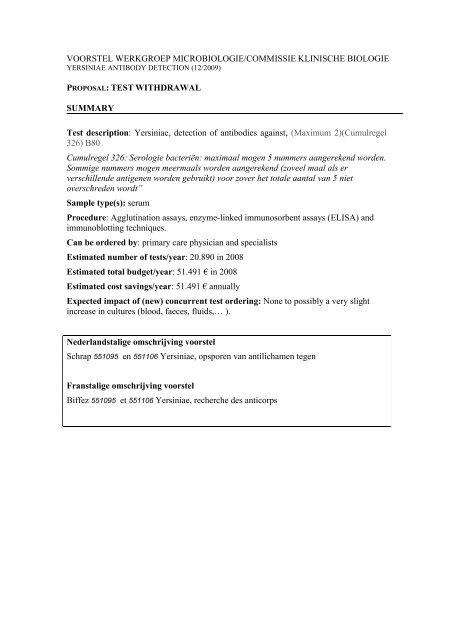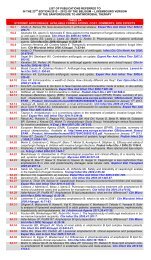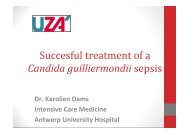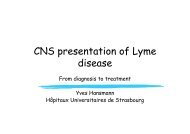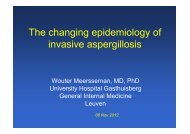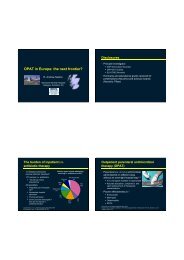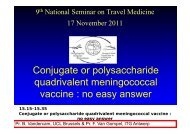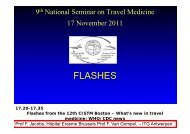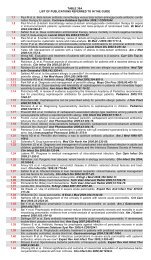Yersinia antibody detection proposal
Yersinia antibody detection proposal
Yersinia antibody detection proposal
You also want an ePaper? Increase the reach of your titles
YUMPU automatically turns print PDFs into web optimized ePapers that Google loves.
VOORSTEL WERKGROEP MICROBIOLOGIE/COMMISSIE KLINISCHE BIOLOGIEYERSINIAE ANTIBODY DETECTION (12/2009)Figure 1: algorithmic approach to the clinical diagnosis of spondyloarthropathies and reactivearthritis4
VOORSTEL WERKGROEP MICROBIOLOGIE/COMMISSIE KLINISCHE BIOLOGIEYERSINIAE ANTIBODY DETECTION (12/2009)APPRAISAL1. Analytical performance characteristics (analytical validation report) of serological tests1.1. Preanalytical considerations (patient variables, sample stability) Biological variationNo dataPatient variables: Childhood, malnutrition and immune suppression are factors that canimpair <strong>antibody</strong> production (Bottone et al., guideline 1)Interferences:o Agglutination tests (Bottone et al., guidelines 1)• Prozone phenomenon• Poor antigen stability can result in false negative reactions• Cross reaction with Brucella spp., Salmonella spp., Morganella spp.,Escherichia coli ,… => Low specificityooELISA• Cross reactivity with Brucella spp.(Benoit et al., original 32)Immunoblot• Possible cross reactivity with Borrelia spp. (Rawlins et al, original 48)Sample stability: Store samples at 2 to 8 °C (no official guidelines)Sample type: SerumSample volume: miminum 100 µl (agglutination test)Prevalence: (estimation of amount of positive test percentage): Depending on the techniqueused and on the cut-off value Target populationNo data1.2 Analytical considerations (Im)PrecisionNo data Accuracy (bias)No dataCorrelation with current method/standardFor a comparison between different serological methods, cfr. 2.1 and 2.2 sensitivity andspecificity. Reproducibility (within run, between run)No data7
VOORSTEL WERKGROEP MICROBIOLOGIE/COMMISSIE KLINISCHE BIOLOGIEYERSINIAE ANTIBODY DETECTION (12/2009)Reference range1. Agglutination tests:Large variation in cut-off values according to different studies. Borg et al. (review 2),Hoogkamp-Korstanje et al. (original 31), Cafferkey et al. (original 17), Gripenberg et al.(original 6), Stolk-Engelaar et al. (original 33),… use a cut-off 1/160. Fendler et al. (original46) use 1/320. Stojek et al. A titer of 1/20(original 41), Larsen et al. (original 14) 1/80 andShenkman et al. (original 1) 1/8. Every significant change in titer on paired sera is believed tobe diagnostic.2. ELISAPositive reaction: at least 2 standard deviations (SD) above the mean of a healthy controlpopulation for IgG AND IgA or IgM. Fendler et al. (original 27) used a cut-off of 3 SD to raisespecificity, but sensitivity dropped with 30%.3. ImmunoblotAccording to the manufacturers instructions.4. FluorescenceA fluorescent signal can be called serotype specific if a dilution of at least 1/240 is stillpositive. At lower lower dilutions, slight cross-reaction with other serotypes is observed. Analytical range/LinearityNo data TATUZLeuven: the (agglutination) test is performed once weekly (Friday). After dilution andincubation, the titers are read on Monday (theoretically, 48 h incubation is enough).For ElISA and immunoblotting techniques, TAT vary from several hours to overnight.1.3 Quality issues CTL (clinical tolerance limits)No data Procedures availableNo data Follow-up internal quality controlNo data Does external quality control exist?No data8
VOORSTEL WERKGROEP MICROBIOLOGIE/COMMISSIE KLINISCHE BIOLOGIEYERSINIAE ANTIBODY DETECTION (12/2009)2. Diagnostic performance of serological tests2.1 Sensitivity, specificityComparison of different <strong>antibody</strong> tests as a tool for the diagnosis of Yersina induced ReA is noteasy for many reasons:There are no exact criteria for the diagnosis of Yersina induced ReA.Different methods are compared.Homemade test are often used in different studies.(Agglutination) assays are prone to false negative and false positive results.In table 3 some examples are shown of studies that report on sensitivity and specificity ofdifferent serological assays. In most studies ELISA and blot techniques show better performancecharacteristics than agglutination assays: Benoit et al. (original 32), Gripenberg et al. (original 6),Chatzipanagiotou et al. (original 45), De Koning et al. (original 21), Fendler et al. (original 46)Hoogkamp-Korstanje et al. (original 31),…2.1 Likelihood ratio’s (LR): no data2.2 NND (number needed to diagnose): no data9
VOORSTEL WERKGROEP MICROBIOLOGIE/COMMISSIE KLINISCHE BIOLOGIEYERSINIAE ANTIBODY DETECTION (12/2009)Hoogkamp-Korstanje etal. (Ref. 16)Fendler et al. (Ref. 27)Population Sensitivity (%) Specifity (%)Culture AgglutinationELISA blot IF CF Culture AgglutinationELISA blot IF CF125 children with80 (97 bij 24 98 85Yersiniosis (acute-chronic) enteritis)20 patients with <strong>Yersinia</strong>20 90 95ReAMäki-Ikola et al. (Ref. 45) 43 culture positive 93 (o.b.vYops-LPS)Rawlins et al. (Ref. 47) 19 blot + en 21 blot - 95 26 82 95Hoogkamp-Korstanje etal. (Ref. 15)Hoogkamp-Korstanje etal. (Ref. 48)10 patients with chronicYersiniosis355 patients: 215 culture +en 140 culture -30 10 100 10018 83 94 29 82 93Table 2: (Some) examples of studies that report on sensitivity and specificity of different serological assays
VOORSTEL WERKGROEP MCIROBIOLOGIE/COMMISSIE KLINISCHE BIOLOGIEYERSINIAE ANTIBODY DETECTION (12/2009)3. Clinical impact3.1 Diagnostic Can other (non) –laboratory examinations be avoided by this test?NOThe result of an <strong>antibody</strong> test alone can not be used as a diagnostic tool, since there are noconsensus guidelines on the diagnosis of <strong>Yersinia</strong> induced sequelae.3.2 Treatment/prognosisDoes the test allow (faster) starting of adequate therapy (or can useless therapy be avoided)?NOSeveral authors have investigated the impact of early antibiotic treatment (original 24, 30, 35).None of them could demonstrate a beneficial effect of (early) antibiotic treatment. Hoogkamp-Korstanje et al. (original 44) found a faster remission and a positive influence on complaints ofpain of 2 x 500 mg ciprofloxacin therapy. Their hypothesis is that ciprofloxacin interferes with<strong>antibody</strong> production (only production of YopD antibodies, less YopH and no YopM antibodies).Whether this explains the impact on the complains remains to be proven.On the other hand, early antibiotic treatment can result in over consumption of antibiotics. Is there a better guidance of therapy by this test?NOIs follow-up of <strong>antibody</strong>-titer indicated?Available information is mainly based on expert opinion. <strong>Yersinia</strong>-specific IgG and IgA aregenerally present for 3 months and disappear after approximately 6 months. IgG can persist forseveral years. Persistence of IgA (mainly anti-YopD IgA) can indicate chronic Yersiniosis. Thispersistence is based on a chronic stimulation of GALT by <strong>Yersinia</strong> antigens.Ganfors et al. (letter 2) investigated the persistence of IgA in ReA patients. They foundpersistence after 6 months of 80% in a group of 56 patients with ReA (39% in control group of 36patiënts). Analysis after 1 year showed persistence of 85% (39 patients) versus 32% in thecontrol group (22 patients).Herlinger et al. (original 28) did a long term (mean: 10.7 years) follow-up of 22 patients after acute<strong>Yersinia</strong> arthritis. They concluded in their paper that there was no association between thepersistence of IgA and/or IgG antibodies and prognosis of the disease. Can toxicity be avoided?NOOn the contrary, risk of toxicity from antibiotics.GENERAL REMARK:Correct diagnosis of ReA (with <strong>Yersinia</strong> as a possible causative agent) can lead to lessaggressive therapies that are used to treat other forms of spondyloarthropathies (SpA). Theprognosis of ReA is generally good (figure 2)
VOORSTEL WERKGROEP MCIROBIOLOGIE/COMMISSIE KLINISCHE BIOLOGIEYERSINIAE ANTIBODY DETECTION (12/2009)Figure 2: Prognosis of reactive arthritis Does conditional reimbursement of medication exist, based on test results?NO3.3. Health outcome Can illness, complications, morbidity, mortality be prevented?No data3.4 OtherAre there epidemiological interests to perform this test? Outbreak monitoring?The sensitivity, specificity and positive predictive value of a raised titer of a monospecific <strong>antibody</strong>is high in an “outbreak setting” (cfr. Pre-test probability). Serology can have an epidemiologicalvalue (Bottone et al, guideline 1) Is the test still in research phase?NO4. Organizational impact12
VOORSTEL WERKGROEP MCIROBIOLOGIE/COMMISSIE KLINISCHE BIOLOGIEYERSINIAE ANTIBODY DETECTION (12/2009)4.1. Impact in the hospital? Length of stay… NO4.2 Impact outside the hospital Patient transportation (POCT,…) NO5. Cost impacts: in and outside the laboratory5.1. (Activity-Based) Cost/test (reagents, personnel, overhead…)Agglutination test: (UZ Leuven data):Total cost of €6.53/test.Immunoblot:According to “diagnostisch kompas” (The Netherlands): €38.80/test5.2 Reimbursement Can other tests be withdrawn?NO5.3 Profit elsewhere in the hospitalNO6. Decision making6.1 Impact on the clinical decision making process and patient management?NO6.2 Overexploitation: YES/underutilization: NO6.3 Incorporated in Clinical Practice Recommendations/Guidelines? Yes, cfr. Sieper et al. (figure1).<strong>Yersinia</strong> <strong>antibody</strong> <strong>detection</strong>: conclusionsAntibody <strong>detection</strong> is NOT USEFUL in the acute phase of a <strong>Yersinia</strong> infectionFor the diagnosis of secondary sequelae of a <strong>Yersinia</strong> infection , especially reactive arthritis,there is an added value to the <strong>detection</strong> <strong>Yersinia</strong> specific antibodies. Nevertheless, there areno evidence based guidelines concerning this matter and pre-test probability is a veryimportant issue. There is neither a proven impact on therapy and prognosis.ELISA and Immunoblot are the preferred techniques, because of better performancecharacteristicsBecause of the unclear diagnostic value of <strong>antibody</strong> testing, the fluctuating quality of theassays and the difficult interpretation of the different tests, a withdrawal of reimbursementof <strong>antibody</strong> testing is proposed. Further testing may be done in a “reference laboratorysetting”.13
VOORSTEL WERKGROEP MCIROBIOLOGIE/COMMISSIE KLINISCHE BIOLOGIEYERSINIAE ANTIBODY DETECTION (12/2009)RELEVANT EVIDENCE/REFERENCESGuidelines:1. Bottone EJ and Sheehan DJ. <strong>Yersinia</strong> enterocolitica: Guidelines for Serologic Diagnosis ofHuman Infections. Reviews of Infectious Diseases 1983; 5(5): 898-906.2. CDC guidelines: Diagnosis and management of Foodborne Illnesses. MMWR 2004; 53 (RR04):1-33.3. Richtlijnen voor <strong>Yersinia</strong>-serologie (Diagnostisch Kompas): www.dk.cvz.nl.Reviews:1. FDA Foodborne Pathogenic Microorganisms and Natural Toxins Handbook: <strong>Yersinia</strong>enterocolitica. http://vm.cfsan.fda.gov 19912. Borg AA, Gray J and Dawes PT. <strong>Yersinia</strong>-related Arthritis in the United Kingdom. A Report of 12Cases and review of the Literature. Quarterly Journal of Medicine 1992; 84(304): 575-582.3. Baert F, Peetermans W and Knockaert D. Yersiniosis: the clinical spectrum. Acta Clinica Belgica1994; 49(2): 76-85.4. Hughes RA and Keat A. Reiter’s Syndrome and Reactive Arthritis: A Current View. Seminars inArthritis and Rheumatism 1994; 24(3): 190-210.5. Taccetti, G, Trapani, S, Ermini M and Falcini F. Reactive arthritis triggered by <strong>Yersinia</strong>enterocolitica: a review of 18 pediatric cases. Clinical and Experimantal Rheumatology 1994; 12:681-684.6. Fomberstein B, Yerra N and Pitchumoni CS. Rheumatological Complications of GI Disorders.The American Journal of Gastroenterology 1996; 91(6): 1090-1103.7. Bottone EJ. <strong>Yersinia</strong> enterocolitica: The Charisma Continues. Clinical Microbiology Reviews1997; 10(2): 257-276.8. Bottone EJ. <strong>Yersinia</strong> enterocolitica: overview and epidemiologic correlates. Microbes andinfection 1999; 323-3339. Smego RA, Frean J and Koornhof HJ. Yersiniosis I: Microbiological and ClinicoepidemiologicalAspects of Plague and Non-Plague infections. European Journal of Clinical Microbiology andInfectious Diseases 1999; 18: 1-15.10. Toivanen A and Toivanen P. Reactive arthritis. Current Opinion in Rheumatology 2000; 12: 300-305.11. Sieper J, Rudwaleit M, Braun J and van der Heijde D. Diagnosing Reactive Arthritis. Arthritis andRheumatism 2002; 46(2): 319-327.12. CDC Division of Bacterial and Mycotic Diseases: <strong>Yersinia</strong> enterocolitica. www.cdc.gov 2005.13. Acheson DWK. Differential diagnosis of microbial foodborne disease. www.uptodate.com 2006.14. Ostroff SM. Basic biology of <strong>Yersinia</strong> infections. www.uptodate.com 2006.15. Ostroff SM. Clinical features; diagnosis; and treatment of <strong>Yersinia</strong> enterocolitica infection.www.uptodate.com 2006.16. Ostroff SM. Epidemiology of yersiniosis. www.uptodate.com 2006.17. Schur PH. Arthritis associated with gastrointestinal disease. www.uptodate.com 2006.18. Yu DT. Patient information: reactive arthritis. www.uptodate.com 2006.19. Yu DT and Wiesenhutter CW. Course and treatment of Reiter’s syndrome, reactive arthritis andundifferentiated spondyloarthropathy. www.uptodate.com 2006.20. Yu DT and Wiesenhutter CW. Definition and diagnosis of undifferentiated spondyloarthropathy,Reiter’s syndrome, and reactive arthritis. www.uptodate.com 2006.Original:1. Shenkman L and Bottone EJ. Antibodies to <strong>Yersinia</strong> enterocolitica in Thyroïd Disease. Annals ofInternal Medicine 1976; 85: 735-739.2. Winblad S. Immune response to <strong>Yersinia</strong> and Pasteurella. In: Rose NR, Friedman H, eds. Manualof clinical immunology. Washington, DC: American Society for Microbiology, 1976: 296-301.14
VOORSTEL WERKGROEP MCIROBIOLOGIE/COMMISSIE KLINISCHE BIOLOGIEYERSINIAE ANTIBODY DETECTION (12/2009)3. Granfors K, Viljanen MK, Ahvonen P and Toivanen P. Measurement of IgM and IgG Antibodiesto <strong>Yersinia</strong> by Solid-Phase Radioimmunoassay. The Journal of Infectious Diseases 1978; 138(2):232-236.4. Fox R, Calin A, Gerber RC and Gibson D. The Chronicity of Symptoms and Disability inReiter’s Syndrome. Annals of Internal Medicine 1979; 91: 190-193.5. Granfors K. Measurement of Immunoglobin M (IgM), IgG and IgA Antibodies Against <strong>Yersinia</strong>enterocolitica by Enzyme-Linked Immunosorbent Assay: Persistence of Serum Antibodies DuringDisease. Journal of Clinical Microbiology 1979; 9(3): 336-341.6. Gripenberg M, Nissinen A, Väisänen E and Linder E. Demonstration of Antibodies Against<strong>Yersinia</strong> enterocolitica Lipopolysaccharide in Human Sera by Enzyme-Linked ImmunosorbentAssay. Journal of Clinical Microbiology 1979; 10(3): 279-284.7. Van Noyen R, Vandepitte J and Wauters G. Nonvalue of Cold Enrichment of Stools for Isolationof <strong>Yersinia</strong> enterocolitica Serotypes 3 and 9 from Patients. Journal of Clinical Microbiology 1980;11(2): 127-131.8. Granfors K, Viljanen MK and Toivanen A. Measurement of Immunoglobin M, Immunoglobin Gand Immunoglobin A Antibodies Against <strong>Yersinia</strong> enterocolitica by Enzyme-LinkedImmunosorbent Assay: Comparison of Lipopolysaccharide and Whole Bacterium as Antigen.Journal of Clinical Microbiology 1981; 14(1): 6-14.9. Head CB, Whitty DA and Ratnam S. Comparative Study of Selective Media for Recovery of<strong>Yersinia</strong> enterocolitica. Journal of Clinical Microbiology 1982; 16(4): 615-621.10. Granfors K, Isomäki H, Von Essen R, Maatela J, Kalliomäki JL and Toivanen A. <strong>Yersinia</strong>antibodies in inflammatory joint diseases. Clinical and Experimental Rheumatology 1983; 1: 215-218.11. Prpic JK, Robins-Browne RM and Davey RB. Differentiation Between Virulent and Avirulent<strong>Yersinia</strong> enterocolitica Isolates by Using Congo Red Agar. Journal of Clinical Microbiology 1983;18(3): 486-490.12. Blake MS, Johnston KH, Russell-Jones GH and Gotschlich EC. A rapid sensitive method of<strong>detection</strong> of alkaline phosphatase conjugated anti-<strong>antibody</strong> on Western blots. Anal Biochem 1984;136: 175-179.13. Hornstein MJ, Jupeau AM, Scavizzi MR, Philippon AM and Grimont PAD. In VitroSusceptibilities of 126 Clinical Isolates of <strong>Yersinia</strong> enterocolitica to 21 β-Lactam Antibiotics.Antimicrobial Agents and Chemotherapy 1985; 27(5): 806-811.14. Larsen JH, Hartzen SH and Parm M. The determination of specific IgA-antibodies to <strong>Yersinia</strong>enterocolitica and their role in enteric infections and their complications. Acta path. Microbial.Immunol. Scand. Sect. B 1985; 93: 331-339.15. Hoogkamp-Korstanje JAA, De Koning J and Samsom JP. Incidence of Human Infection with<strong>Yersinia</strong> enterocolitica Serotypes O3, O8, and O9 and the Use of Indirect Immunofluorescence inDiagnosis. The Journal of Infectious Diseases 1986; 151: 138-141.16. Toma S. Human and Nonhuman Infections Caused by <strong>Yersinia</strong> pseudotuberculosis in Canadafrom 1962 to 1985. Journal of Clinical Microbiology 1986; 24(3): 465-466.17. Cafferkey MT and Buckley TF. Comparison of Saline Agglutination, Antibody to HumanGammaglobulin, and Immunofluorescence Tests in the Routine Serological Diagnosis ofYersiniosis. The Journal of Infectious Diseases 1987; 156(5): 845-848.18. Fukushima H. New Selective Agar Medium for Isolation of Virulent <strong>Yersinia</strong> enterocolitica.Journal of Clinical Microbiology 1987; 25(6): 1068-1073.19. Hoogkamp-Korstanje JAA, de Koning J and Heesemann J. Persistence of <strong>Yersinia</strong> enterocoliticain Man. Infection 1988; 16(2): 81-85.20. Kachoris M, Ruoff KL, Welch K, Kallas W and Ferraro MJ. Routine Culture of Stool Specimensfor <strong>Yersinia</strong> enterocolitica Is Not a Cost-Effective Procedure. Journal of Clinical Microbiology1988; 26(3): 582-583.21. De Koning J, Heesemann J, Hoogkamp-Korstanje JAA, Festen JJM, Houtman PM and Van OijenPLM. <strong>Yersinia</strong> in Intestinal Biopsy Specimens from Patients with SeronegativeSpondyloarthropathy: Correlation with Specific Serum IgA Antibodies. The Journal of InfectiousDiseases 1989; 159(1): 109-112.22. Granfors K, Lahesmaa-Rantala R, Stahlberg TH and Toivanen A. Comparison of Bacteria withand without Plasmid-Encoded Proteins as Antigens for Measurement of Immunoglobin M, G and15
VOORSTEL WERKGROEP MCIROBIOLOGIE/COMMISSIE KLINISCHE BIOLOGIEYERSINIAE ANTIBODY DETECTION (12/2009)42. Wilkinson NZ, Kingsley GH, Jones HW, Sieper J, Braun J and Ward ME. The <strong>detection</strong> of DNAfrom a range of bacterial species in the joints of patients with a variety of arthritides using anested, broad-range polymerase chain reaction. Rheumatology 1999; 38: 260-266.43. Abdel-Haq NM, Asmar BI, Abuhammour WM and Brown WJ. <strong>Yersinia</strong> enterocolitica infection inchildren. Pediatr Infect Dis J 2000; 19: 954-958.44. Hoogkamp-Korstanje JAA, Moesker H and Bruyn GAW. Ciprofloxacin versus placebo fortreatment of <strong>Yersinia</strong> enterocolitica triggered reactive arthritis. Ann Rheum Dis 2000; 59: 914-917.45. Chatzipanagiotou S, Legakis JN, Boufidou F, Petroyianni V and Nicolaou C. Prevalence of<strong>Yersinia</strong> plasmid-encoded outer protein (Yop) class-specific antibodies in patients withHashimoto’s thyroiditis. Clinical Microbiology and Infectious Diseases 2001; 7: 138-143.46. Fendler C, Laitko S, Sörensen H, Gripenberg-Lerche C, Groh A, Uksila J, Granfors K, Braun Jand Sieper J. Frequency of triggering bacteria in patients with reactive arthritis andundifferentiated oligoarthritis and the relative importance of the tests used for diagnosis. AnnRheum Dis 2001; 60: 337-343.47. Hannu T, Mattila L, Nuorti JP, Ruutu P, Mikkola J, Siitonen A and Leirisalo-Repo M. Reactivearthritis after an outbreak of <strong>Yersinia</strong> pseudotuberculosis serotype O:3 infection. Ann Rheum Dis2003; 62: 866-869.48. Rawlins ML, Gerstner C, Hill HR and Litwin CM. Evaluation of a Western Blot Method for theDetection of <strong>Yersinia</strong> Antibodies: Evidence of Serological Cross-Reactivity between <strong>Yersinia</strong>Outer Membrane Proteins and Borrelia burgdorferi. Clinical and Diagnostic LaboratoryImmunology 2005; 12(11): 1269-1274.Letter/Editorial:1. Granfors K and Toivanen A. ELISA and RIA for Serologic Diagnosis of Yersiniosis. Reviews ofinfectious Diseases 1984; 6(3): 421-423.2. Granfors K, Lahesmaa-Rantala R and Toivanen A. IgM, IgG and IgA Antibodies in <strong>Yersinia</strong>infection.The Journal of Infectious Diseases 1988; 157(3): 601-602.3. Chiesa C, Pacifico L and Ravagnan G. Identification of Pathogenic Serotypes of <strong>Yersinia</strong>enterocolitica. Journal of Clinical Microbiology 1993; 31 (8): 2248-2250.4. Sieper J and Braun J. Treatment of reactive arthritis with antibiotics. British Journal ofRheumatology 1998; 37: 715-720.5. Gran JT. Classification and diagnosis of seronegative spondyloarthropathies. Scand J Rheumatol1999; 28: 332-335.6. Inman RD. Classification Criteria for Reactive Arthritis. The Journal of Rheumatology 1999;26(6): 1219-1220.7. Sieper J, Braun J and Kingsley GH. Report on the fourth international workshop on reactivearthritis. Arthritis and Rheumatism 2000; 43(4): 720-734.8. Kobayashi S and Kida I. Reactive Arthritis: Recent Advances and Clinical Manifestations.Internal Medicine 2005; 44(5): 408-412.Textbook:1. Mandell GL. Principles and Practice of Infectious Diseases, 2004, 6 th edition. ChurchillLivingstone.2. Murray PR, Barron EJ, Jorgensen JH, et al. Manual of Clinical Microbiology, 2003, 8 th edition.ASM Press, Washington DC.3. Verbist L en Verhaegen J. Medische microbiologie voor laboranten, 1999, 2 de editie. UitgeverijAcco Leuven.4. Antibioticabeleidgroep. Antibioticagids Universitaire Ziekenhuizen Leuven, 2005.5. Diagnostische en therapeutische gids, R. Verhaeghe-X. Bossuyt en W. Peetermans.6. Harrison’s Principles of internal medicine, 14 th edition, Fauci et al., MacGraw-Hill.7. Reuma, een diagnostisch probleem, 10 de druk, Dequeker, Acco Leuven.8. Yersiniosis: present and future, G. Ravagnan and C. Chiesa (Editors), Karger, Basel.17
VOORSTEL WERKGROEP MCIROBIOLOGIE/COMMISSIE KLINISCHE BIOLOGIEYERSINIAE ANTIBODY DETECTION (12/2009)9. Current investigations of the microbiology of <strong>Yersinia</strong>e., T. Une, T. Maruyama, M. Tsubokura(Editors), Karger, Basel.18


